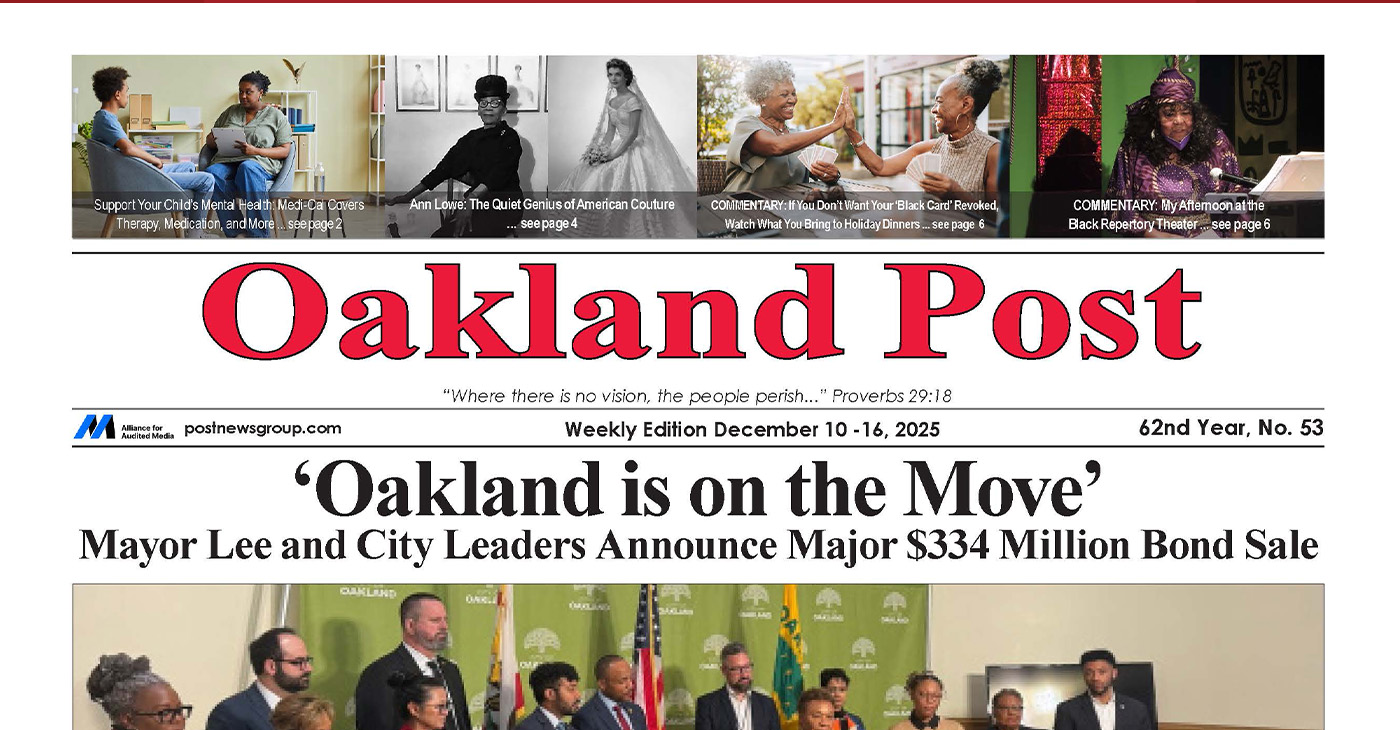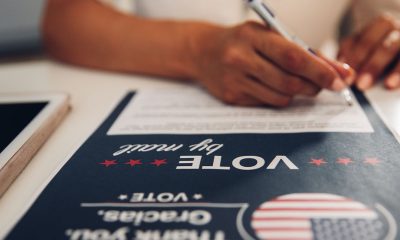National
Attorney Feels Driven to Solve 1940 Slaying of NAACP Member

In this June 10, 2015, photo, retired attorney Jim Emison sits in his home office in Alamo, Tenn. (AP Photo/Mark Humphrey)
Lucas L. Johnson II, ASSOCIATED PRESS
BROWNSVILLE, Tenn. (AP) — The man in the black-and-white photograph on Jim Emison’s desk seems to look right into him, all but demanding to not be forgotten. Emison is doing his best to oblige.
The photo features a man named Elbert Williams and two dozen other charter members of the NAACP’s Brownsville branch, an audacious group of men and women who registered black voters in West Tennessee in the early days of the civil rights movement.
Williams would be dead the following year, killed by unknown assailants in Brownsville on June 20, 1940 — more than two decades before NAACP leader Medgar Evers was gunned down by a Klansman outside his Jackson, Mississippi, home in 1963. Williams’ slaying was never solved, but Emison, a 71-year-old white, retired attorney, hopes to change that.
“We should do everything we can do to see who killed this man,” Emison said. “If there is anybody in a group that may have done it that’s still living, they need to be brought to justice.”
Three-quarters of a century after what some historians believe to be the first NAACP member killed for daring to speak up for civil rights, Emison has gotten federal authorities to take another look at it.
In the process, Emison just might make peace with a ghost from his own family’s past.
Emison’s obsession with Williams’ death grew more out of what he didn’t hear than what he did.
When he was a child, Emison sometimes heard his father, grandfather and uncle — all lawyers — talk about lynchings and other atrocities against African Americans. Once his uncle showed him a tree not far from Brownsville where he said a black man had been hanged.
Emison’s relatives seldom discussed the stories behind the crimes — doing so ran counter to a code of silence typical of small Southern towns. White people who knew about violent racist incidents usually didn’t share their secrets. Black people who had an inkling kept their mouths shut out of fear.
But Emison said the hanging bothered his father, and he talked to him about it.
His father’s uncle had been the Crockett County sheriff. Emison said a mob came to the jail one day in 1929 to seize and lynch an arrested man named Joseph Boxley, who had been accused of assaulting a woman. He said it’s unclear whether the mob forcibly took the man, or the sheriff willingly turned over the key. ButEmison said he’ll never forget his father saying he was afraid his uncle “did not act honorably that night,” words that have haunted Emison to this day.
“When it’s somebody that’s in your family, who may have been able to prevent it and didn’t, then that’s disturbing,” he said.
As a young boy growing up in the South, those conversations fostered a sense of outrage, a growing desire for justice that stayed with Emison during more than 40 years of trying cases in the Brownsville courthouse. Many of his clients were African American. Some of them he represented pro bono.
After all those years in the courthouse, Emison said he was shocked that he hadn’t heard about Williams’ case. And as he learned more, his anger only grew.
“It was just like he was discarded; valueless, worthless,” he said.
In 2012, Emison was researching a story he planned to write about a court case when he came across an online article about two lynchings in 1937 and 1940.
The latter was Williams’ killing. Emison ordered FBI and Department of Justice case files from the U.S. National Archives. To his surprise, officials there sent him un-redacted copies.
The records showed that Brownsville police, upset because the local NAACP branch was registering blacks to vote, had led an effort to force its members out of town. Then-U.S. Assistant Attorney General Wendell Berge said in a letter to U.S. District Attorney William Clanahan that the “obvious purpose” of the police and others had been to “frighten the entire colored population of Brownsville and thus prevent qualified Negroes from exercising their franchise.”
Some of the members left town, but Williams stayed behind. When the police got a tip that he was planning an NAACP meeting at his home, a group of men led by police officer Tip Hunter went to his residence, said they needed to question him outside and then took him away. Williams’ body was found three days later in the nearby Hatchie River.
No autopsy was performed. A coroner’s jury ruled the body was “decomposed so badly we could not make thorough examination” and that the cause of death was believed to be by “foul means by persons unknown.”
Williams’ wife, Annie, and his father identified the body, and she soon moved to New York. Later, in an exclusive interview with the Amsterdam News, a black weekly in New York, Annie Williams said the local authorities had tried to prevent her from seeing her slain husband, and that “the coroner had already issued the order to have the body buried as soon as possible.”
“It was only because I insisted that they let me look at it. It was a terrible sight, but I recognized him. His head was swollen twice its normal size. There were two holes in his chest that looked like bullet holes, the skin on his arms, legs, buttocks was bruised and blistered. His arms and legs, I heard, had been tied with rope and his body weighted down by a heavy log tied around his neck.”
The Justice Department initially ordered the case presented to a federal grand jury, then mysteriously reversed itself and closed the case in early 1942. It did so in spite of evidence gathered by Thurgood Marshall, then special counsel to the NAACP, who went on to become the U.S. Supreme Court’s first African-American justice in 1967.
Emison wants the case reopened and Williams’ body exhumed, despite some resistance from a few people in the community, including one who told him “the past ought to be left to die, and not resurrected.”
But Emison has ignored them. He’s spent hours interviewing Williams’ descendants, relatives of NAACP members from the branch and even family members of two police officers — both now deceased — who went to Williams’ home that night. Relatives of the officers declined interviews with The Associated Press.
Emison even has suspicions about the killers. He believes exhuming the body could lead to a murder weapon, considering Williams’ wife said she saw what looked like bullet holes in his chest. Emison recently turned his findings over to Justice Department officials who he said are giving Williams’ case serious consideration despite the department’s announcement last year that it will likely stop prosecuting civil rights-era murders that occurred in the South.
Williams’ slaying wasn’t among the cases the Justice Department re-examined in recent years, in part because it hadn’t resurfaced until Emison started pushing.
“I am optimistic that they will be interested in this one,” Emison said. “It’s older, but it is of great historic importance.”
Edward Stanton III, the U.S. Attorney for the Western District of Tennessee, told The Associated Press the department is reviewing materials from the case, but didn’t say when a decision will be made.
“We’re giving a strong look at the information provided,” Stanton said.
Leslie McGraw, Williams’ great-niece, called Emison’s efforts “validating.”
“It didn’t seem like anybody was really interested in seeking justice,” said McGraw, who lives in Ann Arbor, Michigan.
Cornell William Brooks, the NAACP’s national president, spoke at a memorial for Williams on Saturday in Brownsville that was attended by more than 500 people. Brooks flew in from Charleston, South Carolina, where just a few days earlier a white gunman killed nine people during a prayer meeting at a historic black church.
During his speech, Brooks called Williams “the first martyr of the NAACP,” and he said those people killed at the church are also martyrs who won’t be soon forgotten.
“These two things are important together,” Brooks said. “Because what it says to me is that no sacrifice should be forgotten; no sacrifice should ever disappear into the sands of time.”
Following the memorial service, a historical marker was unveiled in Williams’ honor and Emison hopes the renewed attention won’t end there.
Patricia Sullivan, a history professor at the University of South Carolina, wrote about Williams’ case in “Lift Every Voice: The NAACP and the Making of the Civil Rights Movement.”
She said his death speaks to the courage required to keep up the fight for civil rights.
“It’s central to understanding what the struggle has been about, and is about,” Sullivan said. “When I look at someone like Elbert Williams … you see that people were willing to risk everything if they thought change was possible.”
When he ponders that photograph on his desk, Emison said he too thinks about the courage it took for the branch members, particularly Williams, to keep pushing to register blacks to vote — knowing they might die.
Emison said that spirit pushes him to solve Williams’ case.
“This is something that I can do for civil rights,” he said. “This is justice.”
Copyright 2015 The Associated Press. All rights reserved. This material may not be published, broadcast, rewritten or redistributed.
###
Activism
Ann Lowe: The Quiet Genius of American Couture
Lowe was born in Clayton, Alabama, into a family of gifted seamstresses. Her mother and grandmother were well-known dressmakers who created exquisite gowns for women in the area. By the time Lowe was a young girl, she was already showing extraordinary talent — cutting, sewing, and decorating fabric with a skill that far exceeded her age. When her mother died unexpectedly, Lowe – only 16 years old then – took over her mother’s sewing business, completing all the orders herself.

By Tamara Shiloh
Ann Cole Lowe, born Dec.14, 1898, was a pioneering American fashion designer whose extraordinary talent shaped some of the most widely recognized and celebrated gowns in U.S. history.
Although she designed dresses for society’s wealthiest families and created masterpieces worn at historic events, Lowe spent much of her life in the shadows — uncredited, underpaid, yet unmatched in skill. Today, she is celebrated as one of the first nationally recognized African American fashion designers and a true visionary in American couture.
Lowe was born in Clayton, Alabama, into a family of gifted seamstresses. Her mother and grandmother were well-known dressmakers who created exquisite gowns for women in the area. By the time Lowe was a young girl, she was already showing extraordinary talent — cutting, sewing, and decorating fabric with a skill that far exceeded her age. When her mother died unexpectedly, Lowe – only 16 years old then – took over her mother’s sewing business, completing all the orders herself. This early responsibility would prepare her for a lifetime of professional excellence.
In 1917, Lowe moved to New York City to study at the S.T. Taylor Design School. Although she was segregated from White students and forced to work separately, she, of course, excelled, graduating earlier than expected. Her instructors quickly recognized that her abilities were far above the typical student, especially her skill in hand-sewing, applique, and intricate floral embellishment – techniques that would become her signature.
Throughout the 1920s and 1930s, she designed gowns for high-society women in Florida and New York, operating boutiques and working for prestigious department stores. Her reputation for craftsmanship, originality, and elegance grew increasingly. She was known for creating gowns that moved beautifully, featured delicate hand-made flowers, and looked sculpted rather than sewn. Many wealthy clients specifically requested “an Ann Lowe gown” for weddings, balls, and galas.
Her most famous creation came in 1953: the wedding gown worn by Jacqueline Bouvier when she married Massachusetts Sen. John F. Kennedy. The dress – crafted from ivory silk taffeta with dozens of tiny, pleated rosettes – became one of the most photographed bridal gowns in American history. Despite this achievement, Lowe received no public credit at the time. When a flood destroyed her completed gowns 10 days before the wedding, she and her seamstresses worked day and night to remake everything – at her own expense. Her dedication and perfectionism never wavered.
She eventually opened “Ann Lowe Originals,” her own salon on New York’s Madison Avenue. She served clients such as the Rockefellers, DuPonts, Vanderbilts, and actresses like Olivia de Havilland. Yet even with her wealthy clientele, she struggled financially, often undercharging because she wanted every dress to be perfect, even if it meant losing money.
Lowe’s contributions were finally recognized later in life. Today, her exquisite gowns are preserved in museums, including the Smithsonian National Museum of African American History and Culture and the Metropolitan Museum of Art.
In the last five years of her life, Lowe lived with her daughter Ruth in Queens, N.Y. She died at her daughter’s home on Feb. 25, 1981, at the age of 82, after an extended illness.
Activism
Oakland Post: Week of December 10 – 16, 2025
The printed Weekly Edition of the Oakland Post: Week of – December 10 – 16, 2025

To enlarge your view of this issue, use the slider, magnifying glass icon or full page icon in the lower right corner of the browser window.
Alameda County
Seth Curry Makes Impressive Debut with the Golden State Warriors
Seth looked comfortable in his new uniform, seamlessly fitting into the Warriors’ offensive and defensive system. He finished the night with an impressive 14 points, becoming one of the team’s top scorers for the game. Seth’s points came in a variety of ways – floaters, spot-up three-pointers, mid-range jumpers, and a handful of aggressive drives that kept the Oklahoma City Thunder defense on its heels.

By Y’Anad Burrell
Tuesday night was anything but ordinary for fans in San Francisco as Seth Curry made his highly anticipated debut as a new member of the Golden State Warriors. Seth didn’t disappoint, delivering a performance that not only showcased his scoring ability but also demonstrated his added value to the team.
At 35, the 12-year NBA veteran on Monday signed a contract to play with the Warriors for the rest of the season.
Seth looked comfortable in his new uniform, seamlessly fitting into the Warriors’ offensive and defensive system. He finished the night with an impressive 14 points, becoming one of the team’s top scorers for the game. Seth’s points came in a variety of ways – floaters, spot-up three-pointers, mid-range jumpers, and a handful of aggressive drives that kept the Oklahoma City Thunder defense on its heels.
One of the most memorable moments of the evening came before Seth even scored his first points. As he checked into the game, the Chase Center erupted into applause, with fans rising to their feet to give the newest Warrior a standing ovation.
The crowd’s reaction was a testament not only to Seth’s reputation as a sharpshooter but also to the excitement he brings to the Warriors. It was clear that fans quickly embraced Seth as one of their own, eager to see what he could bring to the team’s championship aspirations.
Warriors’ superstar Steph Curry – Seth’s brother – did not play due to an injury. One could only imagine what it would be like if the Curry brothers were on the court together. Magic in the making.
Seth’s debut proved to be a turning point for the Warriors. Not only did he contribute on the scoreboard, but he also brought a sense of confidence and composure to the floor.
While their loss last night, OKC 124 – GSW 112, Seth’s impact was a game-changer and there’s more yet to come. Beyond statistics, it was clear that Seth’s presence elevated the team’s performance, giving the Warriors a new force as they look to make a deep playoff run.
-

 Activism4 weeks ago
Activism4 weeks agoIN MEMORIAM: William ‘Bill’ Patterson, 94
-

 #NNPA BlackPress3 weeks ago
#NNPA BlackPress3 weeks agoBeyoncé and Jay-Z make rare public appearance with Lewis Hamilton at Las Vegas Grand Prix
-

 Activism3 weeks ago
Activism3 weeks agoOakland Post: Week of November 19 – 25, 2025
-

 #NNPA BlackPress4 weeks ago
#NNPA BlackPress4 weeks agoLewis Hamilton set to start LAST in Saturday Night’s Las Vegas Grand Prix
-

 #NNPA BlackPress2 weeks ago
#NNPA BlackPress2 weeks agoLIHEAP Funds Released After Weeks of Delay as States and the District Rush to Protect Households from the Cold
-

 Alameda County2 weeks ago
Alameda County2 weeks agoSeth Curry Makes Impressive Debut with the Golden State Warriors
-

 Activism3 weeks ago
Activism3 weeks agoOakland Post: Week of November 26 – December 2, 2025
-

 #NNPA BlackPress2 weeks ago
#NNPA BlackPress2 weeks agoSeven Steps to Help Your Child Build Meaningful Connections




















































